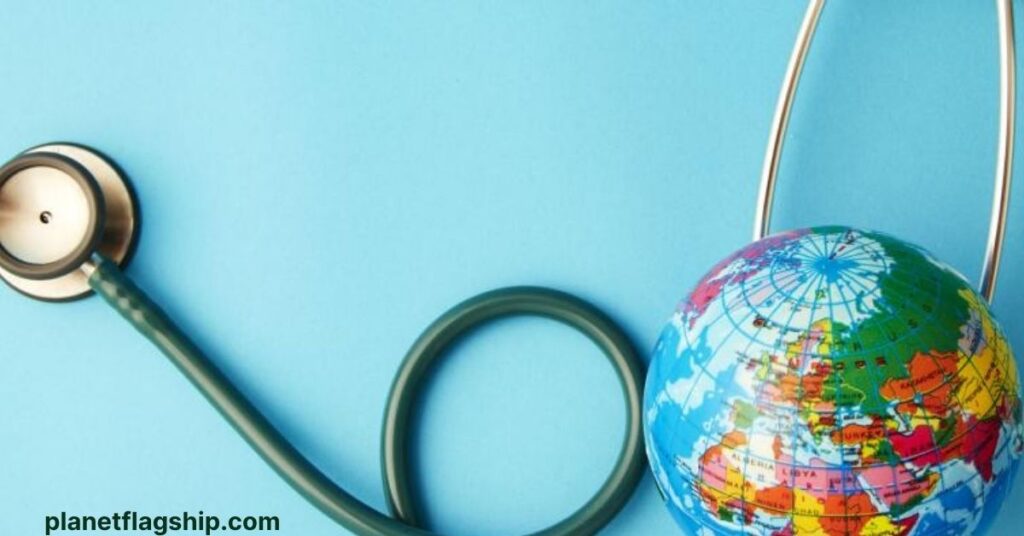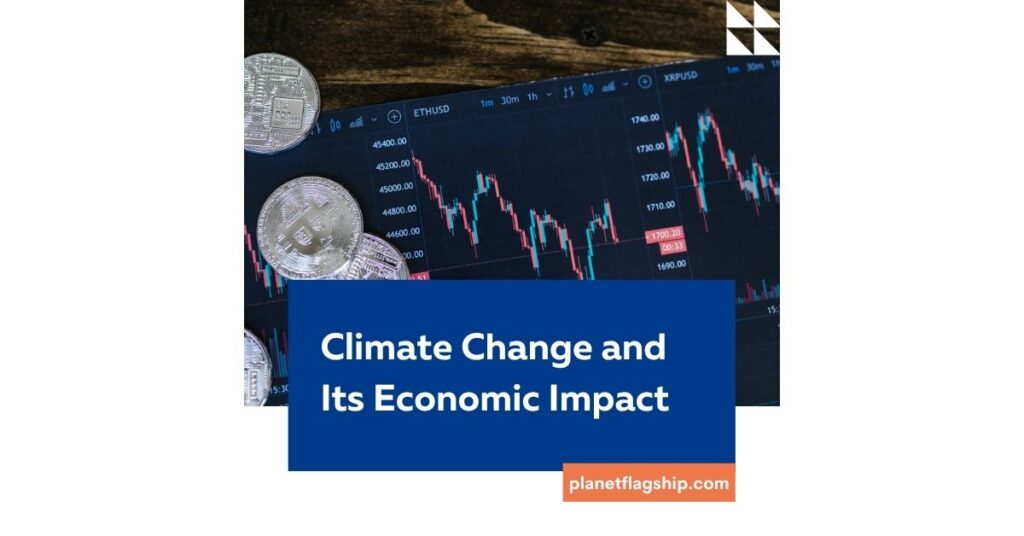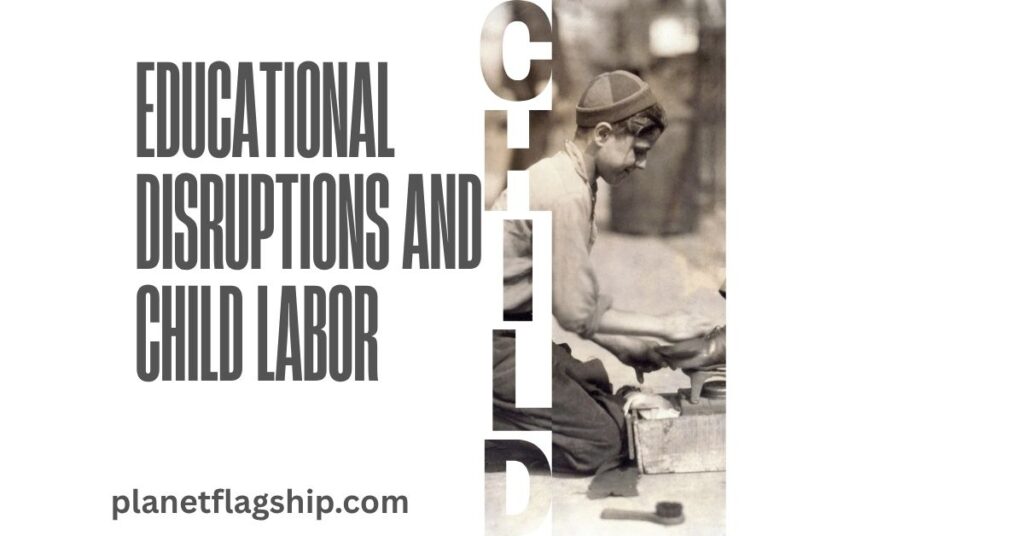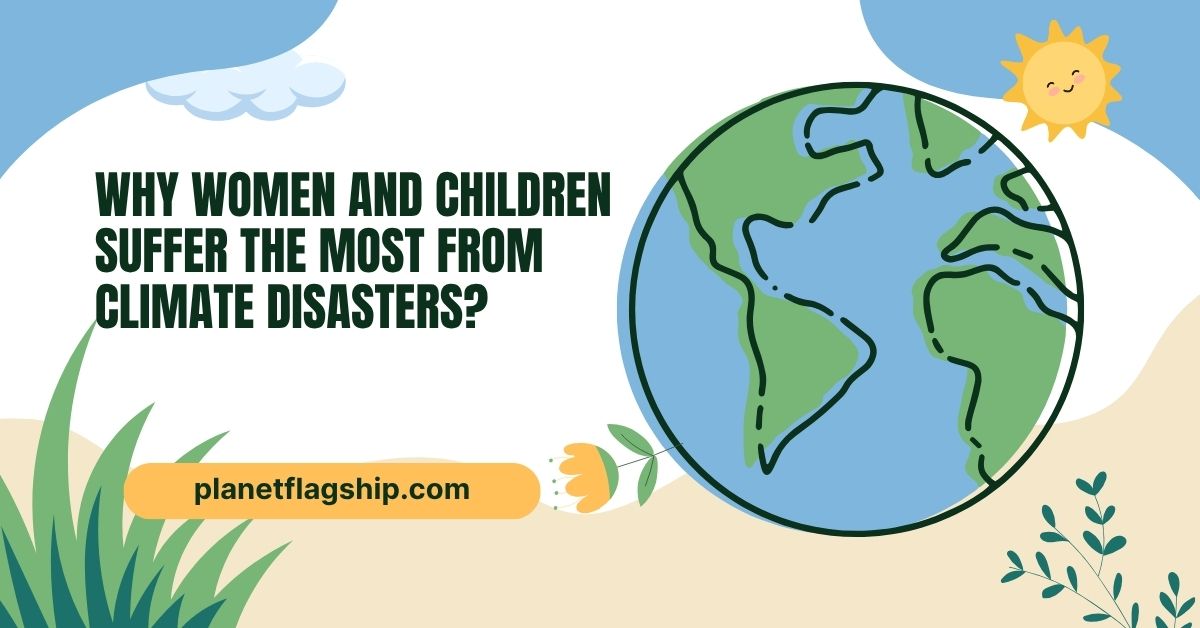Introduction
Climate change has evolved from being a meteorological phenomenon to an interdisciplinary global issue affecting every realm of human life. The increase in frequency and severity of climatic catastrophes, such as floods, droughts, fires, hurricanes, and heatwaves, has significantly impacted the lives of millions of people worldwide. Natural catastrophes afflict unevenly. Instead, they reveal and exacerbate existing inequalities among different groups, disproportionately affecting those who are most at risk. Among these are women and children, who are necessarily the worst-off groups, largely because of highly interlocked sets of socio-economic, cultural, biological, and political factors (UN Women, 2022).
Social organizations and power structures will necessarily determine the connection between climate change and human exposure. In any society, particularly those in the Global South, women and children bear the brunt of social inequalities. Gender roles, cultural norms, unequal access to resources, and restricted involvement in decision-making are all interrelated factors that limit women and children’s ability to prepare for, respond to, and recover from climate disasters (UNFPA, 2022). Climate change is not only an environmental tragedy but also a gendered one that needs an intersectional and inclusive approach to climate policy and disaster management.
One of the most important explanations for this disproportionate suffering is the current socio-economic marginalization of women and children. Women have a higher likelihood of being poor than men in the world, especially in poor and rural communities. The narrative presented by the World Bank (2021) is that the majority of the world’s poor are women, who often have limited access to economic resources, property rights, education, and formal employment. And when the climate disasters strike, women can be without resources to evacuate safely, access healthcare, or recover homes and livelihoods. Such structural disparities considerably erode their resilience and make them rely even further on informal coping strategies that will also fail during a disaster.
Children are then disproportionately impacted due to their physical, emotional, and developmental vulnerability. Children are at higher risk of malnutrition, illness, trauma, and displacement in crises. UNICEF (2023) reports that nearly 1 billion children, approximately half of the world’s children, are in countries at “extremely high risk” for the effects of climate change. The risks include loss of access to education, hunger, and heightened exposure to waterborne illnesses, all of which have long-term effects on health and development. The intergenerational effects of these problems also perpetuate cycles of poverty and inequality.
Climate disasters also increase gender-based violence and exploitation, affecting women and girls disproportionately before, during, and after crises. Following events such as hurricanes, floods, or displacement due to droughts, women are more likely to suffer from sexual violence, trafficking, domestic violence, and forced marriage. ActionAid (2021) documented rising child marriage among girls in Afghan refugee camps, where, owing to sheer poverty and displacement from climate change, parents sold their daughters for marriage to survive. Humanitarian responses neither document nor comprehensively integrate such gendered hazards.
Health inequities also account for the differential impacts on women and children in climate-related occurrences. Women’s health, particularly reproductive and maternal health, is severely affected when health infrastructure is weakened. Without skilled birth attendants or access to emergency obstetric services, pregnant women may face complications. In the 2022 floods in Pakistan, more than 650,000 pregnant women were deprived of maternal services due to the destruction of healthcare facilities (Prevention Web, 2023). Children also benefit from disruptions to immunization programs, exposure to epidemic disease, and mental disorders due to trauma and displacement.
Climate change exacerbates food and water insecurity, disproportionately affecting women and children. Women will become the primary providers of water and food within households, particularly in low-income families. Under conditions of scarcity, social norms can demand that women and girls eat last or least, and then be more at risk of malnourishment. According to AP News (2024), approximately 27% of children under the age of five experience severe food insecurity due to climate-related disruptions in the supply chain and food production. Early malnourishment leads to stunted growth, compromised cognitive development, and heightened risk of disease.
One of the less-covered but more important aspects of this issue is the restricted role of women in governance and decision-making regarding climate. Although central to natural resource management and the long-term survival of populations, women remain largely on the margins of climate negotiations, disaster relief efforts, and recovery efforts. Absent from those settings, their needs and particular needs are not considered nearly as much when policy choices are being made. The UN Chronicle (2022) asserts that increasing women’s opportunities requires tackling the climate crisis while empowering women. Incorporating more women into environmental decision-making not only results in greater equity and justice but also more effective action on climate change.
Education, which is often interrupted by climatic catastrophes, is essential for both short-term subsistence and long-term resilience. Climate-driven disasters may force girls to leave school to care for their siblings or support their families. Girls, following interruptions in school, are more susceptible to early marriage and exploitation, depriving the girls of long-term futures and reinforcing gender disparities (UNESCO, 2022). Keeping the girls, as well as the children, at school even during times of climate crises prevents the cycle of risk.
Cultural and social gender roles also expose them to risk. Women typically perform tasks such as fetching water, preparing meals, caring for children, and attending to older people in the majority of societies. This type of work not only adds extra work for them during climate crises but also exposes them to higher risk. For instance, during floods or droughts, women might need to go long distances to find resources under risky conditions, risking physical debilitation or violence. Policy debates rarely recognize these survival strategies, despite their centrality to community health.
Briefly, higher suffering among women and children in climate disasters is not a coincidence but the result of historically rooted inequalities and vulnerabilities that are exacerbated by environmental pressure. Economic marginalization, poor health infrastructure, gender-based violence, hunger, disruption of education, and exclusion from decision-making collectively create a complex barrier to recovery and climate adaptation for women and children. To make climate responses that are both sustainable and equitable, we must recognize and address these inequalities.
Climate change is not neutral, and its impact cannot be addressed without an open recognition of its differential impact on vulnerable populations. Climate justice must be placed at the forefront of policy, with targeted interventions that empower and safeguard women and children. Through the prioritization of child-centered and gender-sensitive climate adaptation and disaster response planning, the international community can help ensure that no one is left behind in the face of this typical crisis of the time.
ALSO READ: How Youth Activists Are Leading the Fight for Climate Change?
Health and Reproductive Challenges

Climatic catastrophes pose serious risks to public health, and the most vulnerable are children and women. The most critical challenges are those related to access to healthcare, maternal health, and reproductive health. Climatic catastrophes are likely to devastate or severely impact major health infrastructure, disrupting the delivery of basic and emergency care. The 2022 floods partially or destroyed over 1,000 health facilities, according to Prevention Web (2023). It affected the lives of more than 650,000 pregnant women, most of whom had access to maternal health care. They could not access prenatal care, skilled delivery services, or emergency obstetric services, all of which are necessary for safe childbirth. The destruction of health infrastructure also disrupts vaccination campaigns, childcare initiatives, and nutritional assistance, all of which are essential to children’s survival and development in emergencies.
Other than the destruction of infrastructure, rising global temperatures, as a direct consequence of global warming, also have devastating reproductive health implications. With mounting scientific research, it is emerging that heat stress can cause adverse birth outcomes. For instance, one study found that The Guardian (2024) reported an increase in temperature by 1°C during the week preceding birth raises the risk of stillbirth due to heat waves by 6%. This indicates that insidious increases in ambient temperature can have disastrous consequences for pregnant women and their unborn fetuses, particularly in those with very little air-conditioned space or access to climate-resistant health care.
Climate change is also responsible for the spread of vector-borne diseases, such as malaria, dengue, and the Zika virus, which thrive in warmer and more humid conditions. According to UN Women (2022), the extensive spread of these diseases jeopardizes maternal and neonatal health. Pregnant women are especially vulnerable since infection results in abortion, preterm delivery, and congenital disability. For instance, malaria during pregnancy has been linked to infant mortality and low birth weight, and Zika virus infections can lead to microcephaly and other serious fetal brain abnormalities. Heat waves, standing floodwaters after flooding, and disruptions to health services create the perfect conditions for these diseases to spread, adding further pressure to already strained health systems.
In addition, the secondary effects of climatic catastrophes, such as displacement and famine, exacerbate the aforementioned conditions. Women and children in refugee camps or temporary shelters usually lack privacy and sanitation, and thus have impaired personal hygiene or reproductive health. UNFPA (2022) reports that displaced women are less likely to receive antenatal and postnatal care, leading to an increase in complications and mortality. They are also likely to experience waterborne diseases, stunted growth, and delayed development due to poor nutrition and unhygienic conditions.
Finally, health and reproductive problems for women and children in the context of climate emergencies are complex and highly interconnected. These dangers underscore the need to develop climate-resilient health systems, with a focus on specific priorities for women and children in vulnerable regions prone to climatic crises.
Economic Disempowerment and Food Insecurity

Climate disasters compound the already existing economic vulnerabilities, especially for women, who occupy the lowest steps of the socio-economic ladder. Women in most developing nations play a pivotal role in the agricultural sector, farming, food cultivation, and livestock keeping. They remain without land, credit, and decision-making authority despite being irreplaceable. Women constitute a large percentage of global agricultural workers, yet are systematically excluded from formal land rights and access to financial services, according to Women’s World Banking (2023). It is this economic exposure that exposes women to the greatest risk when climatic shocks, such as drought, floods, or storms, destroy animals and crops, disrupt markets, or destroy storage facilities for food. Without titles to land or savings, women have no cushion and not much to fall back on, perpetuating cycles of poverty.
Climate change affects not only women but also children economically, especially in terms of food insecurity. With climate events disrupting crop cultivation and supply chains, the price of food increases, while the nutritional value of food supplies decreases. These impacts are especially severe in impoverished regions, where households already struggle to meet their basic needs. In a UNICEF report that AP News quoted (2024), almost 27% of children under five years old are facing severe poverty from food, with the biggest percentages in sub-Saharan Africa. The deprivation negatively impacts children’s growth, leading to stunted development, weakened immunity, and impaired cognitive functions, all of which have lasting implications.
Climate disasters exacerbate economic marginalization and hunger, primarily affecting women and children. We must address these issues through gender-sensitive economic planning and climate-resilient agriculture, which will empower women and ensure food security for all.
Increased Gender-Based Violence and Exploitation
Climate disasters threaten not only physical survival but also increase social vulnerabilities most importantly, the danger of gender-based violence (GBV) and exploitation. When families are displaced by floods, droughts, or other climate-related shocks, they often find themselves in refugee camps or makeshift shelters with inadequate security, privacy, and infrastructure. These insecure spaces put women and girls at increased risk of physical and sexual violence, trafficking, and domestic violence. According to The News (2023), in the 2004 Indonesian tsunami, there was a drastic surge in cases of sexual trafficking and abuse among orphan girls who were exposed in overpopulated and inadequately secured shelters. These are a couple of examples of how a natural disaster can instantly turn into a protection crisis for vulnerable people.
In most places, poverty, displacement, and gender imbalance also add to the exploitation. For instance, in Afghanistan’s Shaiday refugee camp, families are fighting against war and climate change-induced entrenched poverty, where early and forced marriages are emerging as a startling survival tactic. Girls are most often married off by their parents, according to ActionAid International (2021), in return for economic alleviation or to reduce the number of individuals they have to support. These child marriages deprive girls of education and childhood as well as subject them to lifelong health and psychological damage, including early pregnancy and abuse.
The deterioration in GBV and exploitation during climate emergencies dismantles the highly gendered level of exposure. Effective legal protection, community defense systems, and women- and children-focused emergency response systems are necessary to prevent these exposures from increasing as climate disasters become more frequent. Gender-responsive climate resilience planning must therefore prioritize the security, dignity, and rights of women and girls affected by disasters.
Educational Disruptions and Child Labor

Climate shocks have a shattering impact on children’s learning, typically causing prolonged school closures and wide-scale displacement of families. Floods, droughts, or other extreme occurrences often destroy school facilities or use them as evacuation centers, forcing families to prioritize survival over education. These interruptions disproportionately affect children in already vulnerable communities, in this case, girls, who are most likely to be the first to be taken out of school to assist with caregiving duties or bring home a wage. More than 2 million 6–14-year-old Afghan children engage in child labor, where displacement and poverty due to climate change were identified as significant drivers of the practice by ActionAid International (2021). Girls, especially, face a double burden of domestic and income-generating activities, which further hinders their progress in education and future opportunities.
Interruption of access to education during and after climate disasters has long-term consequences. Not only does this discourage academic advancement, but it also keeps children, especially girls, trapped in the cycle of poverty, making them even more susceptible to exploitation, early marriage, and labor exploitation. In the majority of devastated regions, once children are withdrawn from school due to economic reasons, readmission is increasingly unlikely, especially when families are displaced for extended periods. The emotional trauma of weather disasters also affects the focus and performance of children in school environments, causing them to fall behind in their developmental progress.
Maintaining access to education amidst climate adversity will necessitate the inclusion of resilient infrastructure, mobile pedagogy, and targeted support for students displaced by climate change. In the absence of such action, learning losses incurred through climate crises will entrench disadvantage and vulnerability in the next generation.
Limited Participation in Decision-Making
A second fundamental, but largely overlooked, dimension of women’s vulnerability to climate disasters is their restricted involvement in decision-making. Although women are primary caregivers, farmworkers, and natural resource managers in most societies, particularly in rural and climate-exposed societies, they are frequently excluded from policy discussions and disaster risk reduction processes. This leads to a cycle of exclusion in which women’s particular needs, views, and expertise are overlooked or devalued. As the UN Chronicle (2022) points out, women’s participation is absent from international and national climate talks, leading to gender-blind and inefficient resolutions that do not address the needs of the most vulnerable groups under crisis.
The lack of women’s representation in climate management and disaster response committees undermines the accumulation of balanced and sustainable adaptation measures. UN Women (2022) holds the view that enabling women to hold leadership roles in environmental management enhances both equity and outcome quality because females bring a varied package of priorities and perspectives, especially regarding food, health, and community resilience. But women still face a wide range of structural barriers, such as biased cultural beliefs, illiteracy, scarce information, and low economic levels, all keeping them away from active roles in decision-making areas.
Moreover, the gender mainstreaming of climate adaptation policies receives minimal attention in the institutional architecture of most developing countries. Without policies that foster female leadership, women’s contributions to these areas cannot be fully captured, despite evidence that gender-responsive programs lead to improved resource management and community-based resilience. Closing this gap, therefore, requires concerted action oriented towards dismantling the gendered system and ensuring that women are not only visible but also audible in shaping climate policy and disaster preparedness.
FAQ’s
Why are women more vulnerable during climate disasters?
Women face greater risks in climate disasters due to poverty, limited access to resources, and exclusion from decision-making. They often lack land rights, healthcare, and evacuation support. Social roles like caregiving also expose them to added burdens and danger.
How do climate disasters affect children the most?
Children are physically and emotionally more fragile, making them vulnerable to malnutrition, disease, and displacement. School closures, loss of family income, and trauma disrupt their development. Nearly 1 billion children live in high-risk climate zones.
Does climate change increase gender-based violence?
Yes, climate crises often escalate gender-based violence, especially in refugee camps or shelters lacking security. Displacement, poverty, and chaos lead to higher risks of sexual abuse, trafficking, and forced marriages. Women and girls suffer the most in these unsafe environments.
How does climate change impact education for girls?
Extreme weather can shut down schools or force families to withdraw girls to help at home or earn income. Many girls never return to school, increasing the risk of early marriage and exploitation. This disrupts their future and deepens generational poverty.
Why is women’s participation in climate decisions important?
Women understand their community’s needs and manage resources daily, yet they’re often left out of climate policymaking. Including women leads to better disaster planning and fairer outcomes. Empowering them builds stronger, more resilient communities.
Conclusion
Climate change and its resulting catastrophes, including floods, droughts, storms, and heatwaves, are increasingly threatening the livelihoods and lives of people globally. However, the catastrophes do not equally impact all communities. As demonstrated in this report, women and children are consistently among the hardest hit due to entrenched socio-economic inequalities, entrenched gender-based discrimination, and limited access to resources. Their combined effects of poverty, displacement, health crises, and powerlessness leave them especially vulnerable both in crisis and post-crisis situations.
The underlying reasons for such unequal exposure are structural. Women and children are often the last to be reached, least involved in policy-making, and most at risk of exploitation during and after climate disasters. From reproductive health risk in the context of a disaster to economic marginalization, gender-based violence, interruption of education, and exclusion from decision-making, these obstacles reinforce each other, creating a cycle difficult to break without concerted effort.
An urgent, multi-level response is required to address these disparities. Firstly, gender-sensitive policies must be introduced into all climate response and disaster preparedness policies. This requires knowledge of the roles, needs, and vulnerabilities of women and children in disasters, as well as programs designed to address these needs. For example, health care delivery systems must ensure maternal care even during disaster, and emergency shelters must be equipped with gender-sensitive safety measures to protect against gender-based violence.
Second, increasing access to essential services, including health, nutrition, and education, is critical. Women and children cannot survive without these services when climate disasters strike. This means building resilient systems that can operate even during crisis periods and are designed to focus on serving vulnerable populations.
Third, increased women’s involvement in climate decision-making is essential. Decisions regarding climate adaptation, resource allocation, and disaster readiness must include women. Research demonstrates that women’s leadership in communities not only promotes justice but also leads to more effective and equitable climate outcomes (UN Women, 2022). Eliminating structural barriers to their participation, such as low educational attainment, social stigma, and exclusion from leadership roles, is crucial to achieving this goal.
Finally, there must be a serious emphasis on legal and social protection against gender-based violence and exploitation in the course of and following disasters. Post-disaster environments are often disorganized and anarchic, and this offers an opportunistic context for abuse. Equipping with effective policies, providing legal aid, and training first responders to recognize and stop abuse can work against these threats.
Collectively, the exposures of women and children in climate disasters are not an accident but the legacy of deep-rooted neglect and discrimination. Not only is it an ethical imperative, but it is also a strategic imperative to build climate resilience to address these issues. An internationally effective climate action approach must prioritize women and children, not as victims, but as change agents who can mobilize their communities towards a safer, more equitable, and more sustainable future.
REFERENCES
ActionAid International. (2021). Climate change and child marriage in Afghanistan: The hidden impact of extreme weather.
AP News. (2024, January 10). Children in sub-Saharan Africa are experiencing a growing crisis of food insecurity.
Prevention Web. (2023). Pakistan floods of 2022: Impact on maternal health and health infrastructure. This report is published by the United Nations Office for Disaster Risk Reduction.
The News. (2023, December 5). The news reported on sexual violence and trafficking in Indonesia after the 2004 tsunami. The News.
UN Chronicle. (2022, July 14). Gender-responsive climate action: The need for inclusive policies. United Nations Chronicle.
UN Women. (2022). Climate change and gender equality: A global perspective. United Nations Women.
UNICEF. (2024). The impact of climate change on food security and child malnutrition. UNICEF.
Women’s World Banking. (2023). The role of women in agriculture and the impact of climate change on food security. Women’s World Banking.

John is a professional blogger and passionate advocate for environmental sustainability. With years of experience exploring eco-friendly practices and green innovations, he shares insightful articles on Planet Flagship to inspire a sustainable future. John’s expertise lies in making complex environmental topics accessible and actionable, empowering readers to make meaningful changes for the planet.
